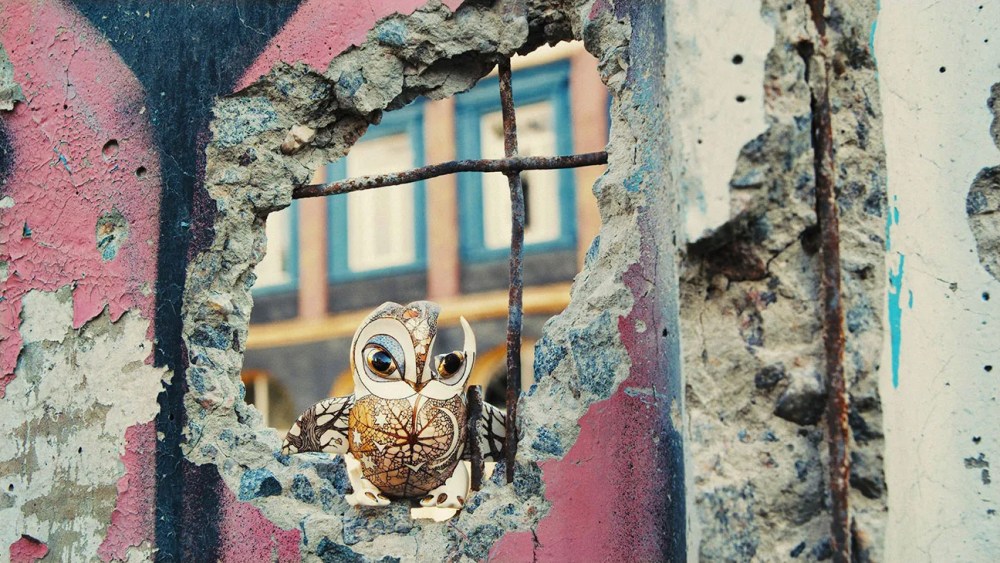Affecting But Patchy Ukraine-Set Documentary
In “Porcelain War,” a resilient Ukrainian couple divide their time between two seemingly antithetical pursuits: When enterprising Slava Leontyev isn’t training fellow civilian soldiers in the ongoing fight against Russia’s invasion, he and his partner Anya Stasenko are skilled ceramic artists, casting and painting dainty porcelain figurines inspired by local nature and folklore. If the title already suggests something pointed in that disparity, this emotive debut by Leontyev and American co-director Brendan Bellomo leaves nothing to chance in ensuring we get it: Porcelain, we are told, is “fragile but everlasting, and can be restored after hundreds of years.” Lest the point still be lost on us, the couple’s combined voiceover later offers a blunter paraphrase: “Ukraine is like porcelain — easy to break, but impossible to destroy.”
The metaphor is clear enough, then; whether it’s quite complex enough to sustain a feature-length documentary is another question. “Porcelain War” thrives on contrast, much of it poignant. Prior to the Russian invasion of Ukraine in February 2022, Slava and Anya lived a bucolic life in rural Crimea, and the film often cuts sharply from gilded magic-hour footage of that idyllic recent past — rambling and foraging in the forest with their scrappy dog Frodo, diving into sun-lacquered lakes, crafting in their rustic cottage — and the cold gray light of their present-day urban existence in war-torn Kharkiv, where they moved instead of fleeing the country altogether. There, his weaponry expertise and her enduring commitment to making art are framed as two halves of a united resistance effort: war balanced by love, bloodshed by beauty.
Enamored of this theoretically unified dichotomy, Leontyev and Bellomo don’t peer too far into its conflicting everyday ramifications, or its effect on the couple’s devoted relationship. Leaps between cozy footage of their domestic life together (complete with the delicate, fanciful art that comes out of it) and queasy first-person combat footage from the Bakhmut frontline are jarring by design, lending this otherwise modestly conceived doc a brute impact that perhaps helped land it the Grand Jury Prize in Sundance’s U.S. Documentary section. What’s missing are the more magnified details, the moral and psychological fallout, of Slava and Anya’s extraordinary routine — now guided by a dual calling to create and destroy.
Leontyev presents his own subjective wartime experience with vivid sensory aplomb, the dynamically roving camera (often directed by his close friend Andrey Stefanov) accompanied by a fevered, clattering score from DakhaBrakha, a self-described “ethic chaos” band based in Kyiv. Less easily articulated anxieties give way to a focus on more poetic ideals and images. Fine porcelain figurines of woodland creatures, their bodies painted with whole bountiful pastel ecosystems, function as a hopeful, even redemptive symbolic counterpoint to the carnage and peril of his current day job; for such small, precious objects, they do rather a lot of heavy lifting. Later, Slava and Anya’s skills overlap to eerier effect when she gives a whimsical paint job to one of the bomber drones deployed by Saigon, his portentously-named military unit of scrappy volunteers: We later see it in action over pinpointed Russian foot soldiers, a colorfully striped dragonfly of death.
The filmmakers make copious use of camera drones to capture these other drones in action; the resulting scenes of aerial warfare are both vertiginously impressive and discomfitingly gung-ho. An accomplished visual effects supervisor whose credits include the 2012 Sundance smash “Beasts of the Southern Wild,” Bellomo is attuned to the jolting sensations of combat both on the ground and above it, and unsurprisingly sympathetic to his subjects’ aesthetic passions. In a couple of artfully animated sequences, their artworks are brought flowingly to life, though the effect is little more than prettifying.
Bellomo isn’t, however, a sufficiently penetrating observer or interviewer to coax out the candid human doubts or fears that his two principal subjects otherwise leave unspoken, and their joint narration feels more stoically inspirational than confessional. “It’s critically important to smile once in a while,” Anya says of their creations, further explaining that she’s “making art for our time, for our country.” But we mostly see Anya in defiantly smiling, hopeful mode; the film’s portrait of a marriage in wartime is touching in its depiction of mutually supportive affection, yet any more anguished intimacy under trying circumstances is kept out of view.
It’s when the film’s attention turns to cameraman Stefanov that a rawer perspective emerges. A former painter who, unlike his friends, feels unable to produce art amid such turmoil, he relates over several devastating minutes the ordeal of driving his wife and two daughters to the safety of the Polish border, narrowly securing their passage in the face of dire traffic queues, gas shortages and Russian shelling, and being permitted only the most cursory of goodbyes as the border gates closed. It’s a disproportionately harrowing testimony for its sidebar positioning in proceedings. Likewise, his desolate concerns that the separation will forever affect his bond with his children hit harder than Anya’s parallel commentary — laid over images of a pristine porcelain mollusc — that “a refugee is a snail without a shell.” In “Porcelain War,” the reality of living in a shattered country tends to outweigh any accompanying metaphor.

